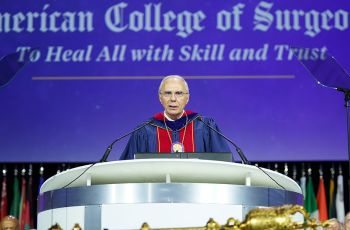
With beaches, pools, and sandal-ready weather, the summer is a time to give your feet a breather – but injuries and foot health should still be a top concern. Your feet are both vulnerable and critical to your overall health and well-being, and going barefoot may not always be the best choice. Arnold Ravick, DPM, podiatrist with the George Washington University (GW) Medical Faculty Associates (MFA), explains how to be on the lookout for plantar fasciitis, warts, and sunburns, and he provides a podiatrist’s picks for summer footwear.
Q. What foot-related health issues are common during the summer?
Ravick: The most common thing we see, period, is plantar fasciitis. It’s even more common in the summer because of people wearing sandals or flip flops, which aren’t as supportive. We’ve also seen a big uptick in plantar fasciitis during the COVID-19 era because people went without shoes in their home for a long period of time. During the summer as well, people step on glass, get splinters, and there are more foreign bodies because people walk around barefoot or in sandals.
Q. What would you recommend people do to prevent these kinds of injuries?
Ravick: My advice is, if you’re just sitting and working or you’re not doing anything, then you can be barefoot. If you’re in the kitchen or cleaning, you definitely want to have some shoes on; you can burn yourself or step on shattered glass.
Much more prevalent is plantar fasciitis. For that, you want shoes that are more supportive. That doesn’t mean they have to be ugly or super hard, but they do have to give you some stability when you walk. There are definitely key things you want to look for: the heel and the back of the shoe need to be strong so it doesn’t move around too much, and the middle of the shoe shouldn’t bend very much. I call it the “fold test.” If you can take your shoe and fold it and stick it in your pocket, it’s not going to support your body weight very well.
Q. Are there other foot conditions you see during this time, such as athlete’s foot or warts?
Ravick: You see athlete’s foot year-round. One of the factors is sweaty feet, and that happens more in the winter months when you’re in closed shoes and socks. In the summer with sandals, you get more air, so you really don’t see athlete’s foot. If you’re in a locker room or in the changing room at a pool, you can get athlete’s foot from someone else, but I think that gets mitigated by the fact that there’s more air around and less sweat.
You will see more warts in the summer because people walk on pool decks and go places where they can pick up that virus.
Q. Are there aspects of foot health that people tend to forget about during the summer?
Ravick: The one thing that people don’t think about is putting sunscreen on your feet. Skin cancer on the foot has had a little bit of an uptick in warmer climates. Any kind of lotion you put on your foot, you want to make sure there’s SPF. When people wear open shoes, I would be much more alert to skin changes on your foot. It could be an indication of some other kind of process going on.
Q. How has the COVID-19 pandemic affected public health, particularly when it comes to fitness and foot care?
Ravick: There’s been a big uptick in fractures and plantar fasciitis because people go barefoot for long periods of time. Before the pandemic, you were putting on shoes to go to work, so you had a different kind of lifestyle. Now, putting shoes on occasionally also speaks to exercise. You don’t want to sit home and do nothing all the time; you want to get out, ride a bicycle, walk for exercise, and get your circulation going. Whatever gets your heart moving is good for your overall health but particularly with your feet; you want them to move, and you want to exercise.
Q. How can GW care for patients with foot injuries or foot health issues?
Ravick: We have a substantial podiatry department at the GW MFA. There are nine of us at GW Hospital and at offices in the D.C. and Chevy Chase, Maryland, area, as well as 2150 Pennsylvania Ave. We also have a wound care center staffed by podiatrists, and we work with our colleagues in orthopedics and other specialties for many different problems. Being part of a university setting in a large group, you have the availability of many more specialists and primary care physicians who can assist. It’s a team approach.
About 75% of Americans experience some kind of foot problem in their life, and only about 20% ever seek care. Most people think it’s the shoes or pedicurist, but there’s a lot of things that we can help with. We want to make people comfortable because when your feet hurt, you can’t walk around, and it certainly changes your lifestyle.
To learn more about foot health or to make an appointment with a podiatrist, call (202) 677-6690 or visit the GW MFA Division of Podiatry.



